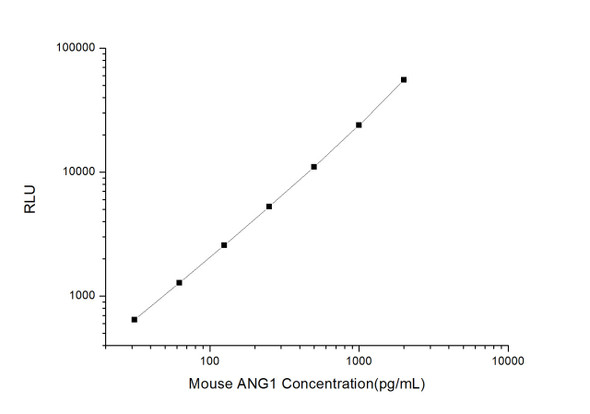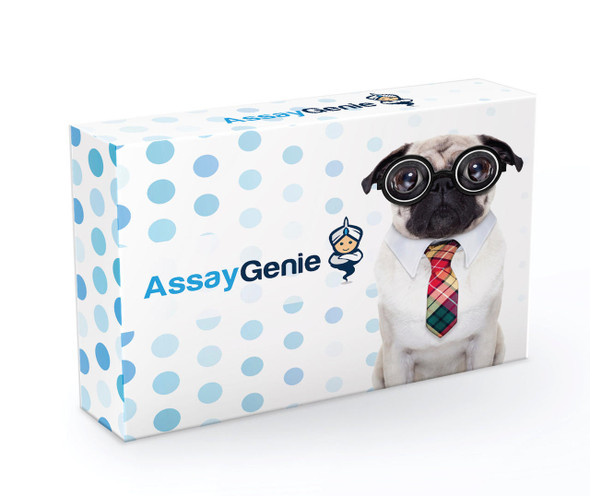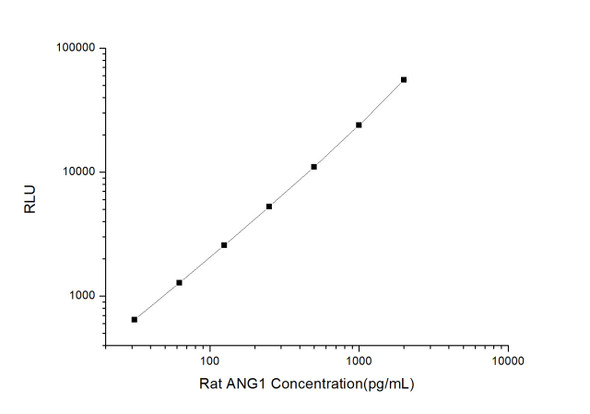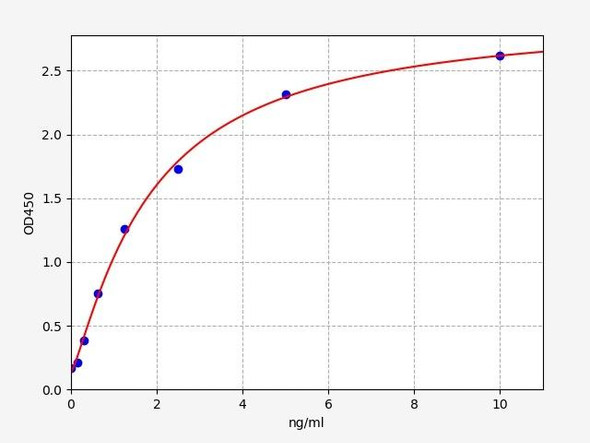Human Cardiovascular ELISA Kits
Human ANG1 (Angiopoietin 1) CLIA Kit (HUES00007)
- SKU:
- HUES00007
- Product Type:
- ELISA Kit
- ELISA Type:
- CLIA Kit
- Size:
- 96 Assays
- Sensitivity:
- 9.38pg/mL
- Range:
- 15.63-1000pg/mL
- ELISA Type:
- Sandwich
- Synonyms:
- ANG-1, ANGPT1, AGP1, AGPT
- Reactivity:
- Human
- Sample Type:
- Serum, plasma and other biological fluids
- Research Area:
- Cardiovascular
Description
| Assay type: | Sandwich |
| Format: | 96T |
| Assay time: | 4.5h |
| Reactivity: | Human |
| Detection method: | Chemiluminescence |
| Detection range: | 15.63-1000 pg/mL |
| Sensitivity: | 9.38 pg/mL |
| Sample volume: | 100µL |
| Sample type: | Serum, plasma and other biological fluids |
| Repeatability: | CV < 15% |
| Specificity: | This kit recognizes Human ANG1 in samples. No significant cross-reactivity or interference between Human ANG1 and analogues was observed. |
This kit uses Sandwich-CLIA as the method. The micro CLIA plate provided in this kit has been pre-coated with an antibody specific to Human ANG1. Standards or samples are added to the appropriate micro CLIA plate wells and combined with the specific antibody. Then a biotinylated detection antibody specific for Human ANG1 and Avidin-Horseradish Peroxidase (HRP) conjugate are added to each micro plate well successively and incubated. Free components are washed away. The substrate solution is added to each well. Only those wells that contain Human ANG1, biotinylated detection antibody and Avidin-HRP conjugate will appear fluorescence. The Relative light unit (RLU) value is measured spectrophotometrically by the Chemiluminescence immunoassay analyzer. The RLU value is positively associated with the concentration of Human ANG1. The concentration of Human ANG1 in the samples can be calculated by comparing the RLU of the samples to the standard curve.
| UniProt Protein Function: | ANGPT1: Binds and activates TEK/TIE2 receptor by inducing its dimerization and tyrosine phosphorylation. Plays an important role in the regulation of angiogenesis, endothelial cell survival, proliferation, migration, adhesion and cell spreading, reorganization of the actin cytoskeleton, but also maintenance of vascular quiescence. Required for normal angiogenesis and heart development during embryogenesis. After birth, activates or inhibits angiogenesis, depending on the context. Inhibits angiogenesis and promotes vascular stability in quiescent vessels, where endothelial cells have tight contacts. In quiescent vessels, ANGPT1 oligomers recruit TEK to cell-cell contacts, forming complexes with TEK molecules from adjoining cells, and this leads to preferential activation of phosphatidylinositol 3-kinase and the AKT1 signaling cascades. In migrating endothelial cells that lack cell-cell adhesions, ANGT1 recruits TEK to contacts with the extracellular matrix, leading to the formation of focal adhesion complexes, activation of PTK2/FAK and of the downstream kinases MAPK1/ERK2 and MAPK3/ERK1, and ultimately to the stimulation of sprouting angiogenesis. Mediates blood vessel maturation/stability. Implicated in endothelial developmental processes later and distinct from that of VEGF. Appears to play a crucial role in mediating reciprocal interactions between the endothelium and surrounding matrix and mesenchyme. |
| UniProt Protein Details: | Protein type:Secreted; Secreted, signal peptide Chromosomal Location of Human Ortholog: 8q23. 1 Cellular Component: extracellular space; microvillus; plasma membrane; extracellular region; lipid raft Molecular Function:receptor tyrosine kinase binding Biological Process: transmembrane receptor protein tyrosine kinase activation (dimerization); positive regulation of cell adhesion; positive regulation of receptor internalization; negative regulation of protein import into nucleus; negative regulation of cell adhesion; positive chemotaxis; negative regulation of protein amino acid phosphorylation; hemopoiesis; negative regulation of neuron apoptosis; regulation of I-kappaB kinase/NF-kappaB cascade; cell differentiation; Tie receptor signaling pathway; regulation of endothelial cell proliferation; in utero embryonic development; positive regulation of blood vessel endothelial cell migration; positive regulation of peptidyl-serine phosphorylation; cell-substrate adhesion; negative regulation of cytokine secretion during immune response; positive regulation of phosphoinositide 3-kinase cascade; positive regulation of protein kinase B signaling cascade; positive regulation of peptidyl-tyrosine phosphorylation; heparin biosynthetic process; positive regulation of protein ubiquitination; regulation of protein binding; negative regulation of vascular permeability; regulation of tumor necrosis factor production; regulation of satellite cell proliferation; sprouting angiogenesis; blood coagulation; leukocyte migration; negative regulation of apoptosis |
| NCBI Summary: | Angiopoietins are proteins with important roles in vascular development and angiogenesis. All angiopoietins bind with similar affinity to an endothelial cell-specific tyrosine-protein kinase receptor. The protein encoded by this gene is a secreted glycoprotein that activates the receptor by inducing its tyrosine phosphorylation. It plays a critical role in mediating reciprocal interactions between the endothelium and surrounding matrix and mesenchyme and inhibits endothelial permeability. The protein also contributes to blood vessel maturation and stability, and may be involved in early development of the heart. Alternative splicing results in multiple transcript variants encoding distinct isoforms. [provided by RefSeq, Dec 2010] |
| UniProt Code: | Q15389 |
| NCBI GenInfo Identifier: | 12229574 |
| NCBI Gene ID: | 284 |
| NCBI Accession: | Q15389. 2 |
| UniProt Secondary Accession: | Q15389,Q5HYA0, |
| UniProt Related Accession: | Q15389 |
| Molecular Weight: | 57,456 Da |
| NCBI Full Name: | Angiopoietin-1 |
| NCBI Synonym Full Names: | angiopoietin 1 |
| NCBI Official Symbol: | ANGPT1 |
| NCBI Official Synonym Symbols: | AGP1; AGPT; ANG1 |
| NCBI Protein Information: | angiopoietin-1; ANG-1 |
| UniProt Protein Name: | Angiopoietin-1 |
| UniProt Gene Name: | ANGPT1 |
| UniProt Entry Name: | ANGP1_HUMAN |
As the RLU values of the standard curve may vary according to the conditions of the actual assay performance (e. g. operator, pipetting technique, washing technique or temperature effects), the operator should establish a standard curve for each test. Typical standard curve and data is provided below for reference only.
| Concentration (pg/mL) | RLU | Average | Corrected |
| 1000 | 50789 56561 | 53675 | 53650 |
| 500 | 21665 23313 | 22489 | 22464 |
| 250 | 10969 9453 | 10211 | 10186 |
| 125 | 4660 5142 | 4901 | 4876 |
| 62.5 | 2538 2368 | 2453 | 2428 |
| 31.25 | 1347 1215 | 1281 | 1256 |
| 15.63 | 691 725 | 708 | 683 |
| 0 | 24 26 | 25 | -- |
Precision
Intra-assay Precision (Precision within an assay): 3 samples with low, mid range and high level Human ANG1 were tested 20 times on one plate, respectively.
Inter-assay Precision (Precision between assays): 3 samples with low, mid range and high level Human ANG1 were tested on 3 different plates, 20 replicates in each plate.
| Intra-assay Precision | Inter-assay Precision | |||||
| Sample | 1 | 2 | 3 | 1 | 2 | 3 |
| n | 20 | 20 | 20 | 20 | 20 | 20 |
| Mean (pg/mL) | 51.07 | 89.30 | 448.85 | 56.10 | 90.66 | 441.97 |
| Standard deviation | 5.22 | 8.96 | 45.92 | 4.55 | 6.96 | 47.38 |
| C V (%) | 10.22 | 10.03 | 10.23 | 8.11 | 7.68 | 10.72 |
Recovery
The recovery of Human ANG1 spiked at three different levels in samples throughout the range of the assay was evaluated in various matrices.
| Sample Type | Range (%) | Average Recovery (%) |
| Serum (n=5) | 91-108 | 98 |
| EDTA plasma (n=5) | 90-102 | 95 |
| Cell culture media (n=5) | 90-106 | 97 |
Linearity
Samples were spiked with high concentrations of Human ANG1 and diluted with Reference Standard & Sample Diluent to produce samples with values within the range of the assay.
| Serum (n=5) | EDTA plasma (n=5) | Cell culture media (n=5) | ||
| 1:2 | Range (%) | 93-109 | 85-97 | 90-102 |
| Average (%) | 100 | 90 | 95 | |
| 1:4 | Range (%) | 95-109 | 88-101 | 90-107 |
| Average (%) | 101 | 95 | 98 | |
| 1:8 | Range (%) | 92-107 | 89-104 | 94-108 |
| Average (%) | 99 | 95 | 101 | |
| 1:16 | Range (%) | 100-117 | 103-119 | 96-110 |
| Average (%) | 107 | 109 | 102 |
An unopened kit can be stored at 4°C for 1 month. If the kit is not used within 1 month, store the items separately according to the following conditions once the kit is received.
| Item | Specifications | Storage |
| Micro CLIA Plate(Dismountable) | 8 wells ×12 strips | -20°C, 6 months |
| Reference Standard | 2 vials | |
| Concentrated Biotinylated Detection Ab (100×) | 1 vial, 120 µL | |
| Concentrated HRP Conjugate (100×) | 1 vial, 120 µL | -20°C(shading light), 6 months |
| Reference Standard & Sample Diluent | 1 vial, 20 mL | 4°C, 6 months |
| Biotinylated Detection Ab Diluent | 1 vial, 14 mL | |
| HRP Conjugate Diluent | 1 vial, 14 mL | |
| Concentrated Wash Buffer (25×) | 1 vial, 30 mL | |
| Substrate Reagent A | 1 vial, 5 mL | 4°C (shading light) |
| Substrate Reagent B | 1 vial, 5 mL | 4°C (shading light) |
| Plate Sealer | 5 pieces | |
| Product Description | 1 copy | |
| Certificate of Analysis | 1 copy |
- Set standard, test sample and control (zero) wells on the pre-coated plate and record theirpositions. It is recommended to measure each standard and sample in duplicate. Note: addall solutions to the bottom of the plate wells while avoiding contact with the well walls. Ensuresolutions do not foam when adding to the wells.
- Aliquot 100µl of standard solutions into the standard wells.
- Add 100µl of Sample / Standard dilution buffer into the control (zero) well.
- Add 100µl of properly diluted sample (serum, plasma, tissue homogenates and otherbiological fluids. ) into test sample wells.
- Cover the plate with the sealer provided in the kit and incubate for 90 min at 37°C.
- Aspirate the liquid from each well, do not wash. Immediately add 100µL of BiotinylatedDetection Ab working solution to each well. Cover the plate with a plate seal and gently mix. Incubate for 1 hour at 37°C.
- Aspirate or decant the solution from the plate and add 350µL of wash buffer to each welland incubate for 1-2 minutes at room temperature. Aspirate the solution from each well andclap the plate on absorbent filter paper to dry. Repeat this process 3 times. Note: a microplatewasher can be used in this step and other wash steps.
- Add 100µL of HRP Conjugate working solution to each well. Cover with a plate seal andincubate for 30 min at 37°C.
- Aspirate or decant the solution from each well. Repeat the wash process for five times asconducted in step 7.
- Add 100µL of Substrate mixture solution to each well. Cover with a new plate seal andincubate for no more than 5 min at 37°C. Protect the plate from light.
- Determine the RLU value of each well immediately.






